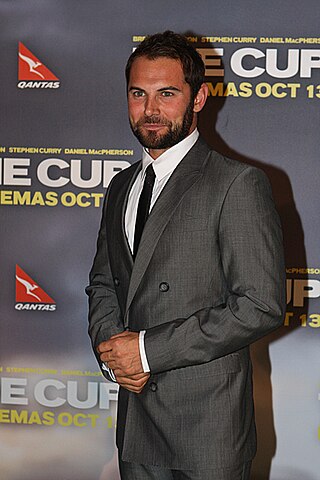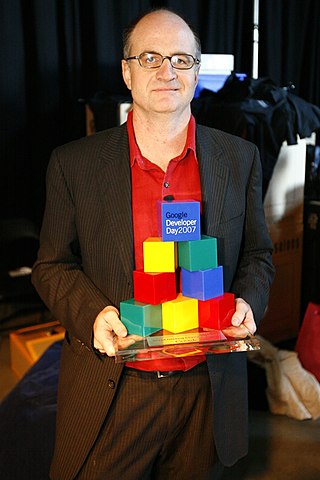
Yoshiro Nakamatsu, also known as Dr. NakaMats, is a Japanese inventor. He regularly appears on Japanese talk shows demonstrating his inventions.

George Charles Devol Jr. was an American inventor, best known for creating Unimate, the first industrial robot. Devol's invention earned him the title "Grandfather of Robotics". The National Inventors Hall of Fame says, "Devol's patent for the first digitally operated programmable robotic arm represents the foundation of the modern robotics industry."

Daniel Donald MacPherson is an Australian actor and television presenter, known for his roles as Joel Samuels in Neighbours, PC Cameron Tait in The Bill, Sergeant Samuel Wyatt in Sky and Cinemax's Strike Back, Whit Carmichael in the Shane Abbess sci-fi film Infini, Arion Elessedil in The Shannara Chronicles and Hugo Crast in the first filmed adaptation of Isaac Asimov's long running Foundation book series, loosely adapted as Foundation. He also co-hosted Dancing with the Stars for six years while simultaneously starring in a number of Australian dramas such as Wild Boys.

It Takes a Thief is an American reality television series that originally aired on the Discovery Channel from February 2, 2005, to April 13, 2007. The program stars and is hosted by Matt Johnston and Jon Douglas Rainey, two former thieves who use their unique expertise to teach people in an unusual way to protect their properties.

Shane Bourne is an Australian stand-up comedian, actor, musician, and television host.

This Is America, Charlie Brown is an eight-part animated television miniseries that depicts a series of events in American history featuring characters from the Charles M. Schulz comic strip Peanuts. It aired from 1988 to 1989 on CBS. The first four episodes aired as a weekly series in October and November 1988; the final four episodes aired monthly from February to May 1989.
American Inventor was a reality television series based on a competition to be named America's best inventor. It was conceived by Simon Cowell and the producers of American Idol, and premiered on ABC in March, 2006. It was organized as a competition between inventors nationally, resulting in one overall winner.
Mayday, Australia, New Zealand, South Africa, the United Kingdom, India, other Asian countries, and some European countries, and Air Emergency, Air Disasters, and Mayday: Air Disaster in the United States, is a Canadian documentary television program examining air crashes, near-crashes, hijackings, bombings, and other disasters. Mayday uses re-enactments and computer-generated imagery to reconstruct the sequence of events leading up to each disaster. In addition, survivors, aviation experts, retired pilots, and crash investigators are interviewed, to explain how the emergencies came about, how they were investigated, and how they might have been prevented.

The New Inventors was an Australian television program, that was broadcast on ABC1 and hosted by broadcaster and comedian James O'Loghlin. Each episode featured three Australian inventions and short video tape packages. IP Australia, a supporter of the program, described it as a way for Australian inventions to gain publicity and possible entrance into the mass market.

Ancient Discoveries is a television series that premiered on December 21, 2003, on The History Channel. The program focused on ancient technologies. The show's theme was that many inventions which are thought to be modern have ancient roots or in some cases may have been lost and then reinvented. The program was a follow-up to a special originally broadcast in 2005 which focused on technologies from the Ancient Roman era such as the Antikythera mechanism and inventors such as Heron of Alexandria. Episodes of the regular series expanded to cover other areas such as Egypt, China and East Asia, and the Islamic world.
The Smithsonian Channel is an American pay television channel owned by Paramount Global through its media networks division under MTV Entertainment Group. It offers video content inspired by the Smithsonian Institution's museums, research facilities and magazines.

The MLB Network is an American television sports channel dedicated to baseball. It is primarily owned by Major League Baseball, with Warner Bros. Discovery through its sports unit, Comcast's NBC Sports Group, Charter Communications, and Cox Communications having minority ownership.

Top Gear is an American motoring television series, based on the BBC series of the same name. The show's presenters were professional racing driver Tanner Foust, actor and comedian Adam Ferrara, and automotive and racing analyst Rutledge Wood. As with the original British version, the show had its own version of The Stig, an anonymous racing driver, and a celebrity guest was featured each week for the first two seasons. The show premiered on November 21, 2010, on History.
The Lemelson Foundation is an American 501(c)(3) private foundation. It was started in 1993 by Jerome H. Lemelson and his wife Dorothy.
Doing DaVinci is a popular science television program originally aired on the Discovery Channel in which the hosts attempted to create many of Leonardo da Vinci's inventions. The show aired on a weekly schedule with the first episode broadcast on April 13, 2009.

Wallace and Gromit's World of Invention is a British science-themed miniseries, starring Peter Sallis, Ashley Jensen, Jem Stansfield, and John Sparkes, produced by Aardman Animations, which aired on BBC One during 2010, from 3 November to 8 December. The programme focuses on inventions based around various themes, and consists of live-action films interlaced with animated claymation segments hosted by characters Wallace and Gromit, featuring a side-plot connected to that episode's theme. While Sallis reprises his role as the voice of Wallace, live-action film segments were either narrated by Jensen or presented by Stansfield, with Sparkes providing the voice of Wallace and Gromit's unseen archivist Goronwy, a unique character for the programme.

Drop Stop is a patented device designed to prevent items from falling between a car's front seats and center console. It was invented by Marc Newburger and Jeffrey Simon of Los Angeles.

Achievement Hunter is an American video gaming division of Rooster Teeth Productions. Founded by Geoff Ramsey and Jack Pattillo on July 6, 2008, the website is largely based on the achievement mechanic in video games. Since its founding, Achievement Hunter has grown to become a core component of Rooster Teeth, hosting a wide variety of videos related to video games. Alongside recurring guests and part-time members, Achievement Hunter videos are currently hosted by several full-time employees: Jack Pattillo, Gavin Free, Michael Jones, Lindsay Jones, Trevor Collins, Alfredo Diaz, Ky Cooke, BlackKrystel, and Joe Lee.
Top Gear is a British motoring magazine and factual television programme, it is a revival of the 1977–2001 show of the same name by Jeremy Clarkson and Andy Wilman for the BBC, and premiered on 20 October 2002. The programme focuses on the examination and reviewing of motor vehicles, primarily cars, though this was expanded upon after the broadcast of its earlier series to incorporate films featuring motoring-based challenges, special races, timed laps of notable cars, and celebrity timed laps on a course specially-designed for the relaunched programme. The programme drew acclaim for its visual and presentation style since its launch, which focused on being generally entertaining to viewers, as well as criticism over the controversial nature of its content. The show was also praised for its occasionally-controversial humour and lore existing in not just the automotive community but in the form of internet memes and jokes. The programme was aired on BBC Two until it was moved to BBC One for its twenty-ninth series in 2020.












